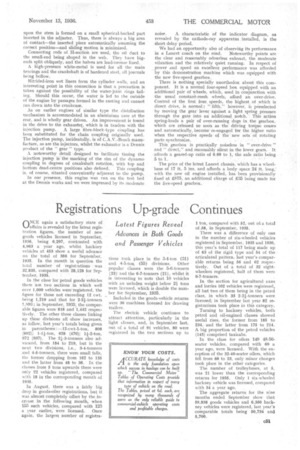Registrations Up-grade Continues
Page 109

If you've noticed an error in this article please click here to report it so we can fix it.
Latest Figures Reveal Advances in Both Goods and Passenger Vehicles
OI-INCE again a satisfactory state of Ii..../affairs is revealed by the latest registration figures, the number of new goods vehicles licensed. in September, 1936, being 6,297, contrasted with 4,963 a year ago, whilst hackney vehicles at 453 show a useful advance on the total of 386 for September, 1935. In the month in question the total number of registrations was 32,835, compared with 28,128 for Sep
tember, 1935. •
In the class for petrol goods vehicles there -are twO sections in which well over 1,000 vehicles were registered, the figure for those not exceeding 12 cwt. being 1,219 and that for 2-24:tonners 1,893 ; in September, 1935; the comparable figures were•818 and -1,442 respectively. The other three classes linking up these divisions all -show increases, as follow, last year's totals being given in parentheses :-12-cwt-1-ton, 808 (602); 1-11-ton, 628 (470); 14-2-ton, 972 (937). The 21,-3-tonners also advanced, from 184 to 219, but in the next two divisions, i.e., 3-4-tonners and 4-5-tonners, there were small falls, the former dropping from 162 to 135 and the latter from 48 to 38. In the classes from 5 tons upwards there were only 22 vehicles registered, compared with 18 in the corresponding month of 1935.
In August, there was a fairly big drop in goods-oiler registrations, but it was almost completely Offset by the increase in the following month, when 155 such vehicles, compared with 123 a year earlier, were licensed. Once again, the largest number of registra tions took place in the 3-4-ton (31) and 4-5-ton, (55) divisions. Other popular classes were the 5-6-tonners (23)" and the 6-7-tonners (21), whilst it is interesting to note that 10 vehicles with an unladen weight below 21 tons were licensed, which is double the num ber for September, 1935. .• Included .in the goods-vehicle returns were 36 machines licensed for drawing • trailers.
The electric vehicle continues to attract attention, particularly in the light classes, and, in September last, out of a total of 91 vehicles, 80 were registered in the two sections up to 1 ton, compared with 52, out of a total of ,58, in September, 1935.
There was a difference of only one in the number of six-wheeled vehicles registered in September, 1935 and 1936. this year's total of 117 being made up of 63 of the rigid type and 54 of the articulated pattern, last year's comparable returns being 56 and 62 respectively. Out of a total of 32 eightwheelers registered, half of them were 6-7-tOnners.
In the section for agricultural vans and lorries 102 vehicles were registered, all hut two of them being in the petrol class, in which 33 2-21-tonners were licensed; in September last year 82 registrations took place in this category.
Turning to hackney vehicles, both petrol and oil-engined classes showed useful rises, the former from 185 to 234,• and the latter from 175 to 214. A big proportion of the petrol vehicles (145) comprised taxicabs.
In the class for oilers 149 48-56seater vehicles, compared with 69 a year ago, were licensed. With the exception of the 32-40-seater oilers, which fell from 66 to 23, only minor changes took place in the other categories.
The number of trolleybuses, at 5, was 21 lower than the corresponding returns for 1935. Only 1 six-wheeled hackney vehicle was licensed, compared with 34 a year ago.
The aggregate returns for the nine months ended September show that 59,838 goods vehicles and 6,350 hackney vehicles were registered, last year's comparable totals being 50,734 and 5,700.








































































































































































